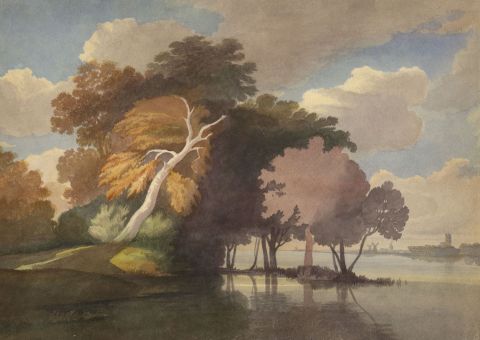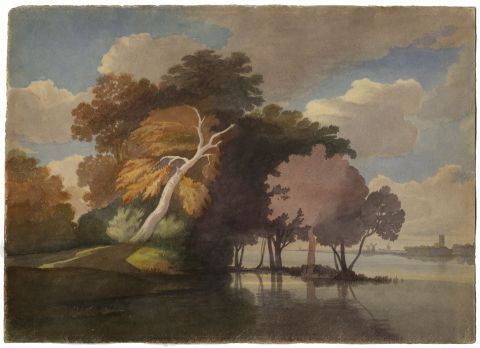This website uses cookies to ensure you get the best experience on our website. Learn more.
After John Sell Cotman, Norfolk Landscape with Trees – 1847 watercolour painting
An original 1847 watercolour painting, After John Sell Cotman, Norfolk Landscape with Trees.
A striking large watercolour which appears to be a student copy after John Sell Cotman (1782–1842); the painting is inscribed 'J.S. Cotman' on the verso. In the 1820s Cotman had returned to his home town of Norwich to run a school (1823–33), then in 1834 he moved back to London to become drawing master at King's College School, retaining that position for the rest of his life. Part of his teaching practice was to lend students examples of his watercolours to copy.
This watercolour bears Cotman's distinctive style of painting in flat planes of transparent colour, and his dramatic juxtaposition of light and dark forms. The visual impact of his compositions was enhanced by his precise control of the edges of these forms, using a method of 'holding out' whites by painting around them rather than by scraping or sponging them out.
This serene landscape features a broad, flat, watery horizon, with windmills and church tower, characteristic of Cotman's native Norfolk. The colour palette is particularly attractive, with autumnal shades of orange, brown and purple.
On watercolour paper.
All artworks come with a Certificate of Authenticity and—if it is a collection artwork—its accompanying collection text or artist biography.
Details
Signed: Inscribed with artist's name verso.
Inscribed: No.
Dated: Dated verso.
Condition: Overall in good condition for its age. There is wear at the periphery of the painting and to the edges of the paper, which could be effectively mounted out. Minor rubbing to the paint towards the lower edge. Please see photos for detail.
Presented: Unframed.
The celebrated watercolourist and engraver John Sell Cotman (1782–1842), one of the leading lights of the Norwich School of painting, was born in Norwich, the son of a wealthy silk merchant. Desperate to seek his artistic fortune, he moved to London at the tender age of 16, where he worked as a printer and engraver. London at the turn of the century had a vibrant watercolour community, and it was during this time that he was introduced to J.M.W. Turner and Thomas Girtin. It was under Girtin that Cotman developed the vibrant and detailed watercolour style that he is known for today. He exhibited a selection of works at the Royal Academy in 1800, at the age of 18, showing a fine hand for English watercolour landscapes, that rivalled the works of Turner and many other contemporary artists. Around 1806 Cotman returned to Norwich, where he became a teaching instructor in the fine arts, and briefly retired from the business of watercolour. He was appointed president to the Norwich Society of Artists in 1811, and it was around this time that he began steady work in engraving. From 1812 to 1823 he lived on the coast near Great Yarmouth, and travelled across England and abroad to Normandy to study the land and sea, producing a significant number of published volumes of etchings and engravings. Though he made a lucrative career out of this, it was watercolour that continued to call to him, and he began to exhibit again slowly in London, until he moved there formally in 1834 when he was appointed as Master of Landscape Drawing at King’s College School. It was in this role that he trained a young Dante-Gabriel Rossetti, as well as his own two sons Miles Edmund Cotman and John Joseph Cotman, who went on to become painters of stature. He died in London in 1842. His works can be found in collections at the British Museum, Tate Britain, and the V&A; Newton ‘Cotman’ watercolours bear his name to this day.



